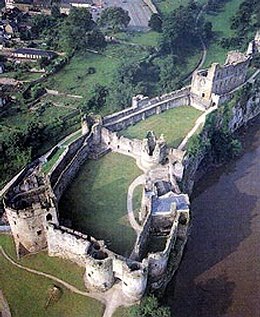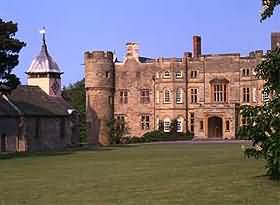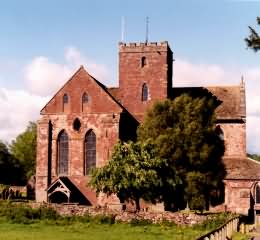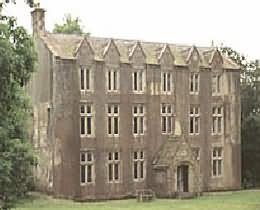|
Historical attractions
in the Royal Forest of Dean, Herefordshire and Monmouthshire are many and varied. You will
find here details of most of the popular venues with tourists to the region.
The contents
cover Berkeley
Castle, Eastnor and Chepstow Castles,
Tudor and Jacabeon Manor Houses and Stately Homes. You will also find folk Museums and
Historic sites including the the magnificent Cathedral at Hereford also
included are the Chained Library and the Mappa
Mundi.
|
|
| Abergavenny Castle |
|
Abergavenny Castle is located just a short walk from the main shopping area of Abergavenny. Enough of the castle remains to indicate that it must have been a fairly formidable fortress. The castle has Norman origins: the motte was built by Hamelin de Ballon, the Norman conqueror of this area in 1090. Soon after a stone keep was built on the motte and the present Victorian 'keep' probably stands on its foundations. In 1175 Abergavenny Castle was the scene of an infamous act: the Massacre of Abergavenny. Henry, the third son of Milo Fitzwalter was killed by Seisyll ap Dynfnwal in 1175. As there were no other other male heir, the castle and Brecknockshire and Upper Gwent passed to his mother Bertha who was a daughter of Milo Fitzwalter. William de Braose decided to avenge the death of his uncle Henry. He summoned Seisyll ap Dyfnwal, his son Geoffrey and a number of other local Welshmen from Gwent to Abergavenny Castle for a reconciliation meeting. They were all murdered and their lands were taken. Control of the castle passed back and forth during the turbulent years as the Welsh Marches changed hands in the twelfth century between the English and Welsh forces. During the thirteenth and fourteeth centuries a huge amount building work was undertaken on the castle whilst it was in the hands of the Hastings family. The most prominent features that remain from this period are the towers in the western corner of the castle.
The keep along with most of the other castle buildings, was destroyed in the Civil War, between 1645 - 1646. In 1818, the present building - now the Museum - was constructed on top of the motte as a hunting lodge for the Marquess of Abergavenny. |
 |
| Location |
Contact |
| Castle Street, Abergavenny, Monmouthshire |
|
| South of the town, on the A40. |
|
| |
Tel: 01873 854282 |
Admission |
Opening |
| |
Daily all year except Sundays November to February |
| |
|
| Notes: |
|
|
| Belmont Abbey |
|
Belmont Abbey, the home of a community of Benedictine monks, is set in extensive gardens. The Abbey Church was built as the pro-Cathedral or Wales in 1859 to the design of E W Pugin. Visitors are welcome to join the monks in their daily round of prayer. Refreshments are available at Hedley Lodge, originally the monastic guesthouse.
|
 |
| Location |
Contact Tel: |
Belmont Abbey
Hereford
HR2 9RZ
Tel: 01432 374747 |
Take the A465, Hereford-Abergavenny road from Hereford. After the 'Tesco' roundabout, take the first right and the Abbey entrance is on the left. |
| Web: www.belmontabbey.org.uk |
| Admission |
|
Opening and Admission:
Abbey Church: free
Gardens: by permission/donation |
Opening Daily:Open all year |
| |
|
| Notes: |
|
|
| Berkeley Castle |
|
Berkeley Castle is one of the March Castles, built to keep out the Welsh, and has all the trappings to match: trip steps designed to make the enemy stumble during an assault, arrow slits, murder holes, enormous barred doors, slots where the portcullis once fell, and worn stones where sentries stood guard. It is also a fairytale Castle with its warm pink stone that glows in soft sunset light. Outside, the battlements drop some 60' to the Great Lawn below; but inside the Inner Courtyard, the building is on a human scale, with uneven battlements, small towers, doors and windows of every shape and size. The surrounding land would have been flooded for defence.
For accommodation see Wotton-under-Edge and Stroud.For Place to Eat nearby see Stagecoach Inn . |
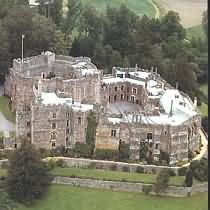 |
| Location |
Contact |
| Berkeley Castle, Gloustershire, GL13 9BQ |
Tel: 01453 810332 |
| Web: www.berkeley-castle.com |
| Admission |
Opening |
| Adults £5.70 Child £3.10, Concs £4.70 |
Daily: Open April to September |
| |
|
| Notes: |
|
|
| Berrington Hall |
|
Berrington Hall was built for Thomas Harley, the son of the 3rd Earl of Oxford. He made a fortune supplying pay and clothing to the British Army in America and became Lord Mayor of London in 1767 at the age of 37.
Harley acquired the Berrington estate in 1775 and immediately commissioned 'Capability' Brown to work on the grounds. Brown took advantage of the panoramic situation of the estate and created a beautiful parkland with a artificial lake and island. The house was built between 1778 - 1781 on a site advised by Brown. This was above the wide valley of a tributary of the River Lugg with views to the Black Mountains and Brecon Beacons. The house was designed by Brown's son-in-law, the fashionable architect Henry Holland, who created Carlton House for the Prince Regent. The rooms contain a collection of French furniture, including pieces that belonged to the Comte de Flahault, the natural son of Napoleon's step-daughter Hortense and Talleyrand. Harley's daughter, who inherited the estate, was married to the 2nd Lord Rodney, son of Admiral Rodney. The dining room is decorated with huge panoramic paintings of sea battles, three by Thomas Luny, in tribute to the distinguished Admiral who played a significant role in the American War of Independence. |
 |
| Location |
Contact |
| 3 miles North of Leominster |
Berrington Hall, Leominster, HR6 0DW |
| Web:- nationaltrust.org.uk |
| |
Tel: - 01568 615721 |
| Admission |
Opening |
| Adult £5, Child £2.50 |
Times vary - phone for details |
| Notes:- 1. Beautiful ceilings and spectacular hall staircase 2. Good collection of furniture and paintings. |
|
|
The Rodney family continued at Berrington Hall until 1900 when the estate was sold to Frederick Cawley, later Lord Cawley. Lady Cawley's room displays a photograph of the 1st Lord Cawley and his four sons on horseback in front of the house.
A few years later three of their sons were killed in the First World War.
In 1957 Berrington Hall was accepted by the Treasury in payment of death duty and transferred to the National Trust with some of the contents. The Trust has had to replace much of the pinkish ashlar stonework outside but the remarkable original interior is in a superb state of preservation. |
|
| Bromyard Heritage Centre |
|
The Heritage Centre is a short walk from Bromyard town centre. This museum is dedicated to Hops and Hop Picking. The displays explore the history of hops and hop growing in some detail and follow the year of the hop from winter maintenance of the hop fields through to the summer and autumn picking. The displays include life-size scenes from hop picking life and many original artifacts and tools.There are workshops for children, which take place during the school holidays. The displays are on the ground floor and accessible to wheelchair users. Admission is free
If you are a member of the Bromyard community and would like to stage a small exhibition at the Heritage Centre, please contact a member of staff on site to discuss the project
|
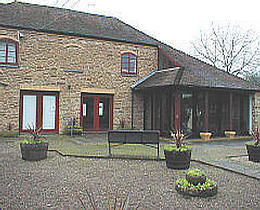 |
| Location |
Contact |
| Bromyard town centre |
Bromyard Heritage Centre Rowberry Street, Bromyard HR7 4DU . Tel:(01432) 260692 |
| Admission Free |
Opening |
| Please phone for details.Tel: 01432 260692 |
Thursday to Monday, 6th July to end of November, 10am – 4pm |
| Notes: |
|
|
| Brockhampton Estate |
|
This 1700 acre estate was bequeathed to the National Trust in 1946 and still maintains traditional farms and extensive areas of woodland, including ancient oak and beech. Located on the Herefordshire/Worcestershire borders.
At the heart of the Brockhampton estate lies Lower Brockhampton House - a medieval 14th-C moated manor house with a beautiful timber framed gatehouse. Visitors can see the Great Hall, open to the rafters which were constructed from wood from the estate.
Discover the ruined Norman Chapel near to Lower Brockhampton.
There are miles of walks across the Brockhampton estate through park and woodland and includes sculptures with a local theme.
The Brockhampton Estate is home to a rich variety of wildlife including the dormouse, buzzard and raven.
Sample the local specialities in the tearoom and visit the imaginatively stocked shop selling mostly local produce and crafts.
The ground floor of Lower Brockhampton House and tearoom are accessible. Please telephone 01885 488099 for details of facilities for visitors with disabilities. |
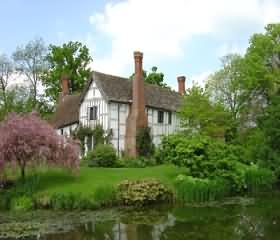 |
| Location |
Contact |
| 2 miles east of Bromyard on the A44. |
Brockhampton Estate, Greenfields, Bringsty, WR6 5TB |
| |
|
| Web: nationaltrust.org.uk |
| |
Tel - 01885- 488099 |
| Admission |
Opening |
| Adult £3.60, Child £1.80 |
House - Mar Sat & Sun 12 noon to 4pm; Apr to Sep Wed to Sun 12 noon to 5pm; Oct Wed to Sun 12noon to 4pm. Estate - All year dawn to dusk |
| |
| |
|
|
| Caldicot Castle |
|
Founded by the Normans, developed in royal hands as a stronghold in the Middle Ages and restored as a Victorian family home, the castle is set in 55 acres of beautiful parkland. take an audio tour, explore the medieval towers and enjoy breath-taking views from the battlements.
The Children's Activity Station includes puzzles and games, tree and leaf identification, draw your own shields and armour and the chance to make a castle to take home. Find out about footwear in the past and try on a selection of shoes copied from original historical examples. From medieval slippers and a Tudor buckle shoe, to a shoe from the time of the English Civil War and a Victorian lady's ankle boot, this activity lets you step back in time.
The river Neddern winds its way through areas of woodland and pasture and the wildlife pond is complete with a pond-dipping station.The park offers an ideal setting for picnics and walks against the magnificent backdrop of the medieval castle walls, with picnic tables and barbecue hearths on site. |
 |
| Location |
Contact |
| From the M4 take junction 23 & the B4245. From the M48 take junction2,the A48 & B4245. Signed from the B4245
|
Church road, Monmouthshire, NP26 4HU Tel: 01291 420421 |
| Web: www.caldicotecastle.co.uk |
| Admission |
Opening |
| Please phone for details |
Daily: Mar-Oct 11am-5pm |
| Notes: |
|
|
| Chained Library |
|
The Chained Library at Hereford Cathedral is a unique and fascinating treasure in Britain's rich heritage of library history.
There were books at Hereford Cathedral long before there was a 'library' in the modern sense. The cathedral's earliest and most important book is the eight-century Hereford Gospels; it is one of 229 medieval manuscripts which now occupy two bays of the Chained Library.
Chaining books was the most widespread and effective security system in European libraries from the middle ages to the eighteenth century, and Hereford Cathedral's seventeenth-century Chained Library is the largest to survive with all its chains, rods and locks intact.
A chain is attached at one end to the front cover of each book; the other end is slotted on to a rod running along the bottom of each shelf. The system allows a book to be taken from the shelf and read at the desk, but not to be removed from the bookcase. The books are shelved with their for edges, rather than their spines, facing the reader (the wrong way round to us); this allows the book to be lifted down and opened without needing to be turned around - thus avoiding tangling the chain. The specially designed chamber in the New Library Building not only means that the whole library can now be seen in its original arrangement as it was from 1611 to 1841, but also allows the books to be kept in controlled environmental conditions according to modern standards of presentation.There has been a working theological library at the cathedral since the twelfth century, and the whole library continues to serve the cathedral's work and witness both as a research centre and as a tourist attraction. |
  |
| Location |
Contact |
| Hereford town centre |
Hereford Cathedral, 5 College Cloisters, Cathedral Close, Hereford HR1 2NG |
| |
|
| Web: www. herefordcathedral.co.uk |
| |
Tel: 01432 374200 |
Admission |
Opening |
| Adult £4.50, Child £3.50 |
Daily - Summer Mon to Sat 10am to 4.15pm. Winter Mon to Sat 11am to 3.15pm. |
| Notes:- 1. The world's largest chained library - 1500 rare books |
|
|
| Cider Museum |
|
Explore the story of traditional cider making: How apples were harvested, milled and pressed, and how the resulting juice was fermented to produce cider.
You can also walk through a reconstruction farm cider house and see the 300year-old travelling cider maker's 'tack'.
The Cider Museum, which opened to the public in 1981, is an independent Charitable Trust, and was created through the efforts of Mr. Bertram Bulmer, when he retired as chairman of H.P.Bulmer Ltd., the largest cider maker in the world. The collection of machinery and other cider making equipment, advertising material, photographs and newspaper cuttings from 1760, has grown to some 26,000 items.
The Museum is designed to look at the whole cider making industry worldwide, from its earliest beginnings through to the mass production methods which exist today. Unique in the United Kingdom, the Cider Museum is the only registered museum devoted entirely to cider and perry-making. |
 |
| Location |
Contact |
| In W Hereford, off A438 |
21 Rylands Street, Hereford. HR4 0LW |
| Admission |
Tel: 01432 354207 |
| Adults £2.70, Child & Concs £2.20 |
www.cidermuseum.co.uk |
| |
Opening |
| |
Daily: Apr-Oct 10am-5pm Nov- Dec 11am-3pm Jan-Mar Tue-Sun 11am-3pm |
| |
|
| Notes:1. Visit the original champagne cellars 2. See the distillation process being used for cider brandy |
|
|
| Eastnor Castle |
|
Looking like a Medieval Welsh border fortress, Eastnor Castle was built in the early 19th Century, by John, First Lord Somers, and is a good example of the great Norman and Gothic revival in architecture of that time.
The Castle is dramatically situated in a 5000 acre estate in the Malvern Hills and remains the family home of the Hervey-Bathursts, his direct descendants.
The Castle is as dramatic inside as it is outside, a vast 60 foot high hall leads to a series of State rooms, including a Gothic drawing room designed by Pugin, with its original furniture, and a Library in the style of the Italian renaissance, with views across the lake.
The Fairytale Georgian Castle is surrounded by deer park, lake and famous arboretum. Richly decorated Gothic and Italianate interiors with Medieval Armour. Children's playground, garden centre and maze, special events programme. Eastnor Castle is also a popular venue for corporate private entertainment with luxury overnight accommodation.
Eastnor is all about trees. The arboretum planted by Lord Somers from 1852 to 1883 is now mature, and full of champion specimens. Many are rare, including a tall American beech ({Fagus grandifolia}) and an enormous red hickory ({Carya ovalis}). It is however the conifers which dominate the setting for the neo-Norman Castle, largely because they were planted so thickly and in such great numbers.
|
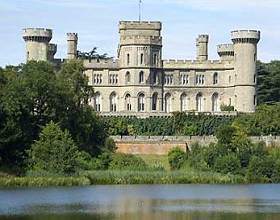 |
| Details |
| Nearest Train Station: |
Ledbury |
| Nearest UK Airport: |
Birmingham |
| Months Open: |
Sundays and BH Mondays from Easter - 1st weekend in Oct
Every day in July & Aug except Saturdays
11am - 5pm (last admission 4.30pm) |
| Groups/Parties Welcome: |
Yes |
| Discount for Groups: |
Yes |
| Car Parking: |
Yes |
| Admission Price: |
Adults: £7
Senior Citizens: £6
Children: £4
Family Ticket (2 adults, 3 children): £18 |
| Gift Shop: |
Yes |
| Catering: |
Cafe |
| Website |
www.eastnorcastle.com |
|
|
| Gloucester Folk Museum |
|
Gloucester Folk Museum is one of the oldest-established museums dedicated to social history. The collections have been drawn together through mainly gifts from the entire county of Gloucestershire, and represent one of the most fascinating collections of such material.
From treen (small wooden items), to the intriguing story of the river Severn fisheries; from historic costume to the life of the dairy; from the reconstructed Victorian classroom to the original pin factory - all of these plus hundreds of other elements of our local history are to be found here.
Set in Tudor timber-framed buildings, one of which was traditionally associated with the final night of the protestant martyr, Bishop Hooper, the Folk Museum is a complex of rooms on different levels and with a unique ambience that makes it a popular sight for locals and visitors. Behind the chocolate-box facade is a museum which is both larger than seems possible, and constantly surprising. No visit to Gloucestershire is complete without seeing the treasures and curiosities on display here. |
 |
| Location |
Contact |
Gloustershire city centre
nr the docks |
99-103 Westgate Street GL1 2PG |
| |
|
| |
|
Admission Free |
Opening |
| |
Tue - Sat 10am - 5pm |
| Notes 1:Exhibition of domestic life- Kitchen & Laundry 2: Displays of Dairy, Ironmongers and Carpenters |
|
|
| Goodrich Castle |
|
This fortified baronial palace stands majestically on a red sandstone crag, commanding the passage of the river Wye into the picturesque wooded valley of Symonds Yat. Much of the stone used was quarried from the rock around the base of the castle, creating a deep moat.
The history of Goodrich castle can be traced back almost a thousand years to it's early establishment by Godric Marplestone hence it's original name of 'Godric's Castle'. The ruins that remain are those of a castle that was built in the late 1130's in the reign of King Stephen by Gilbert de Clare and later the outer stone walls and turrets were added by Walter Marshal the 5th Earl of Pembroke between 1220AD and 1245AD.
Walter Marshall died in 1245AD childless and the castle passed to the Crown and so to Henry III's half brother William de Valence who continued to add to the castle's defences.
The castle is said to be haunted by Alice Birch (Colonel Birch's niece) and her lover Charles Clifford who were drowned while trying to flee across the swollen River Wye during the siege, it's claimed that on a stormy night their ghostly figures can be seen riding a phantom horse and again trying to make that fateful crossing. |
 |
| Location |
Contact |
| 5 Miles south of Ross on Wye off A40 |
Ross on Wye HR9 6HY 01600 890538 |
| |
|
| Web: www.english-heritage.org.uk |
| |
|
| Admission |
Opening |
| Adults £3.70 Child £1.90 Concs £2.80 |
Daily: Apr-Sep 10am-6pm Oct 10pm-5pm
Nov-Mar Wed-Sun 10am-1pm & 2pm-4pm |
| Notes 1:Cannon that destroyed the castle in 1645 is now on display 2: Views over the river Wye and Symonds Yat |
|
|
| Hampton Court |
|
Hampton Court was the estate of King Henry IV of England prior to his ascension to the throne. The estate was then bestowed as a reward for a knight's bravery at Agincourt, and the manor home took shape in the 1430s. Hampton Court became famous throughout Europe in the eighteenth century for its formal gardens. Since its acquisition in 1994, Hampton Court has been carefully restored to its former splendour, and its gardens are once again a sight to behold.
There is a maze of a thousand yews with a gothic tower at its centre. Climb to the top for a panoramic view of the gardens or descend underground to a tunnel that leads to a waterfall in the sunken garden. Beautiful herbaceous borders stretch out from a one hundred and fifty year old wisteria tunnel that leads to vast lawns and ancient trees beside the castle. Beyond the lawns are riverside and woodland walks.
Adjoining the castle, in a grand conservatory designed by Joseph Paxton, is the Orangery Restaurant. Here delicious lunches and teas can be enjoyed.
|
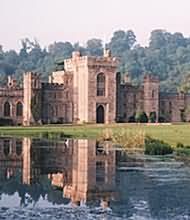 |
| Location |
Contact |
| A417 near junction withA49 |
Hampton Court Gardens, Hope under Dinmore, Leominster, HR6 0PN |
| Web: hamptoncourt.org.uk |
| |
|
| Admission |
Opening |
| Adult £5, Child £3 |
From March 25th - October 30th 2005 Tues, Weds, Thurs and weekends 11am-5pm (last admission 4pm) |
| Notes:-Organically managed site. |
|
|
| Hartpury Historic Buildings |
|
Clustered around Hartpury church are a unique group of ancient buildings lovingly maintained over the centuries by the parishioners. Many of these now need the careful attention of experts to continue to keep them in good order. Hartpury Historic Buildings Trust was established both arrange this and equally importantly to let others know about this gem lying off the beaten track. Find out more by exploring this site or ideally by visiting Hartpury village.
The most significant addition to the group of buildings that surround the church was the construction in 1829 of a chapel attached to a wing of Hartpury Court. It was built for the Dominican nuns who fled to Hartpury during the French revolution. Account books for the period show that Robert Canning, the Lord of the Manor, erected the shell of the building and the nuns were then responsible for the internal fittings. A small cottage consisting of two rooms on the ground floor and two above, was built adjoining the chapel. The ground floor room to the north had a connecting door to the Chapel and was probably used as a vestry. The two rooms on the first floor were no doubt occupied by the nuns' priest.
The published histories were all agreed, the Bee Shelter was medieval, built for the convent of Holy Trinity at Caen in Normandy. The stone came from Caen and the honey and wax when harvested were taken there. The fascinating structure comprised 28 stone recesses or boles supported on Tudor arches ?Tudor? - ?medieval? the 'listing' description said 17th century! The experts even questioned whether it was Caen stone! |
 |
| Location |
Contact |
| From Gloucester, follow A417 towards Ledbury. Once in village of Hartpury follow brown and white signs |
Church Road, Hartpury, Gloucester, GL19 3DE Tel: 01531 822144 |
Getting there
By road: A417 Gloucester - Ledbury road, approximately 4 miles north of the junction with the A40, 8 miles south of the junction with the M50 (J2).
By rail: Nearest mainline station is Gloucester (Wales & West and Great Western trains)
By bus: Service S51 from Gloucester Bus Station (infrequent service) |
|
| www.hartpuryhistoric.org |
Admission: Free
Parking Free
Opening Daily: daylight hours |
|
|
| Hereford Cathedral |
|
Standing on the peaceful banks of the beautiful River Wye, Hereford Cathedral occupies a site on which cathedral buildings have stood since Saxon times.
The present building contains some of the finest examples of architectural excellence from Norman times up to the present day, including the beautifully restored Shrine of St. Thomas of Hereford in the North Transept, the exquisite Early English Lady Chapel and the ' high-tech Medieval ' New Library Building completed in 1996. Hereford Cathedral's medieval Mappa Mundi and Chained library - two of Britain's most important historical treasures - are now exhibited together in the award -winning New Library Building (designed by Whitfield Partners and funded by a generous gift from Mr. John Paul Getty Jr.) at the West end of Hereford Cathedral.
Here the Chained Library can be seen together in its original glory for the first time in 150 years.
The exhibition is open all year round.
The stories of these national treasures are told through models, original artifacts and the latest interactive computer technology. |
 |
| Location |
Contact |
| Hereford town centre |
Hereford Cathedral, 5 College Cloisters, Cathedral Close, Hereford HR1 2NG |
| |
|
| Web: www. herefordcathedral.co.uk |
| |
Tel: 01432 374200 |
| Admission |
Opening |
| Adult £4.50, Child £3.50 |
Daily - Summer Mon to Sat 10am to 4.15pm. Winter Mon to Sat 11am to 3.15pm. |
| Notes:- 1. The world's largest chained library - 1500 rare books 2. Working stonemasons yard. |
|
|
| Mappa Mundi |
|
The Hereford Mappa Mundi is unique in Britain's heritage; an outstanding treasure of the medieval world, it records how thirteenth-century scholars interpreted the world in spiritual as well as geographical terms.
The map bears the name of its author 'Richard of Haldingham or Lafford' (Holdingham and Sleaford in Lincolnshire). Recent research suggests a date of about 1300 for the creation of the map. Mappa Mundi is drawn on a single sheet of vellum (calf skin) measuring 64" by 52" (1.58 x 1.33 meters), tapering towards the top with a rounded apex. The geographical material of the map is contained within a circle measuring 52" in diameter and reflects the thinking of the medieval church with Jerusalem at the centre of the world.
Superimposed on to the continents are drawings of the history of humankind and the marvels of the natural world. These 500 or so drawings include of around 420 cities and towns, 15 Biblical events, 33 plants, animals, birds and strange creatures, 32 images of the peoples of the world and 8 pictures from classical mythology. Christopher de Hamel, a leading authority on medieval manuscripts, has said of the Mappa Mundi, '... it is without parallel the most important and most celebrated medieval map in any form, the most remarkable illustrated English manuscript of any kind, and certainly the greatest extant thirteenth-century pictorial manuscript.' |
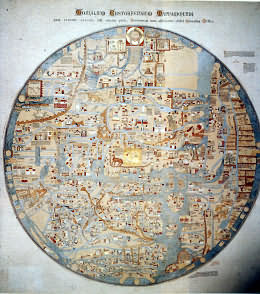 |
| Location |
Contact |
| Hereford town centre |
Hereford Cathedral, 5 College Cloisters, Cathedral Close, Hereford HR1 2NG |
| |
|
| Web: www.herefordcathedral.co.uk |
| |
Tel: 01432 374200 |
| Admission |
Opening |
| Adult £4.50, Child £3.50 |
Daily - Summer Mon to Sat 10am to 4.15pm. Winter Mon to Sat 11am to 3.15pm. |
| |
|
|
| Nelson Museum & Local History Centre |
|
Horatio Nelson was born in Norfolk, died at sea and is buried in London. However, Monmouth is home to one of the best collections of Nelson paraphernalia in the world. Find out about Monmouth’s magnificent collection of materials about the famous Admiral, and
learn about his life, loves, death and commemoration.
The Nelson Museum was founded in 1924, following the bequest to Monmouth by Lady Llangattock of her collection of material relating to the famous admiral. The museum moved to the current premises (a market hall complex built in the 1830s) in 1969, at which time the local history collections for the town were incorporated.
The Local History centre, in the same building, deals with Monmouth and its people, including Charles Rolls of Rolls Royce fame and Henry V.
The Nelson collection includes both personal and commemorative material, and is particularly noted for the large number of personal letters. Star exhibits include Nelson's fighting sword, and a selection of outrageous forgeries, including Nelson's glass eye.
|
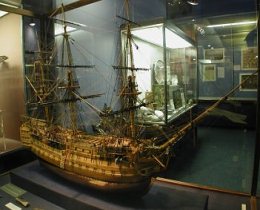 |
| Location |
Contact Tel: |
New Market Hall
Priory Street
Monmouth
NP25 3XA |
(Tel) : 01600 710630
(Fax) : 01600 710631
|
| Web: www.monmouthshire
.gov.uk/ |
| Monday to Saturday (incl. Bank Holidays) 10.00-13.00, 14.00-17.00; Sunday 14.00-17.00. |
Opening - Open all year Closed - Christmas & New Year |
| Admission |
Free to all |
|
|
| Raglan Castle |
|
Raglan castle is one of the finest late medieval buildings in the British Isles and, although now ruined, it remains a striking presence in the landscape of south-east Wales. Much of what remains at Raglan dates from the 15th-century, the period of the War of the Roses and the rise of the Tudor dynasty. The Great Tower is the most impressive of the buildings from this period, dominating the two courtyards of the castle. It was built either by William Herbert or his father, William ap Thomas, who had purchased Raglan in 1432. This, and other contemporary works at the castle, are clear evidence of a family whose wealth and political importance were in the ascendance. William Herbert was a key figure in the politics of the late 15th-century. During the War of the Roses he threw in his lot with the Yorkists, supporting Edward IV in his climb towards the throne. The reward for his loyalty was considerable, providing him with the title Earl of Pembroke, and sufficient resources to convert Raglan into a palace-fortress. Earl William's success was, however, to be short-lived. In 1469 he was captured by Lancastrian supporters at the Battle of Edgecote and put to death. The Herberts retained control of Raglan until 1492 when it passed to the Somerset family. William Somerset, the third Earl of Worcester (1526-1589), was the first of his family to significantly alter the castle's buildings. Earl William focused his efforts on upgrading the quality of the hall and service ranges to meet the social expectations of his time. He also established the gardens that were to be such a feature of Elizabethan and Jacobean Raglan, including a series of walled terraces, an artificial lake, a fountain, flower beds and herb gardens. By the middle of the 17th-century, Raglan's fortunes were at their peak.
Raglan was abandoned and left to decay, becoming a convenient source of building material and a picturesque tourist attraction. Today this decay has been halted and the building conserved through the work of Cadw and its predecessors, guardians of the castle since 1938. |
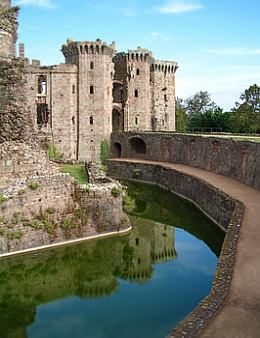 |
| Location |
Contact |
| ½m N of Raglan, 7m SW of Monmouth, off A40 |
www.cadw.wales.gov.uk |
| |
|
| |
Tel: 01291 690228 |
Admission |
Opening |
| Adult - £2.90, Concession - £2.50, Family - £8.30 |
Apr - May: 9.30 - 17.00
Jun - Sep: 9.30 - 18.00
Oct: 9.30 - 17.00
Nov - Mar: 9.30 -16.00
Monday - Saturday,
Sunday 11.00 - 16.00 |
| |
|
| Notes: |
|
|
| Tintern Abbey |
|
| Tintern Abbey was originally founded by Cistercian monks in 1131 AD. in the reign of Henry I. Between 1270 and 1301 the Abbey was rebuilt and by the end of the rebuilding, around four hundred monks lived in the complex. The Black Death arrived in 1349 and affected Abbey life badly but it continued to operate until 1536. In that year the Abbey was part of the dissolution of the monasteries under Henry VIII. Within a few years the lead was stripped from the roof and the building began to decay. The Abbey then became a source of building stone and only in the eighteenth century was any interest shown in the ruin. Around 1760 the site was cleaned up and visitors to the Wye Valley began to be entranced with the beauty of the site and surroundings. The abbey and its setting in a River Wye valley have long inspired British artists.The artist, William Turner (1775-1851) was a visitor and he painted spectacular views of Tintern Abbey. Turner's beautiful picture of the interior showed chickens scratching around an unkempt, grassy floor. |
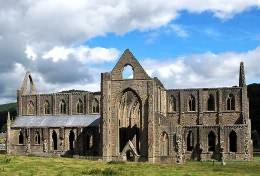 |
| Location |
Contact |
| Off the A466 4m North off Chepstow |
Cadw, Welsh Historic Monuments, Cathays Park, Cardiff CF10 3NQ |
| |
|
| |
Tel: 01291 689251 |
Admission |
Opening |
| Adults £3.00 Child £2.50, Concs £2.50 |
Daily: 1 Apr -1 Jun
9.30am-5pm 2 Jun -28 Sep 9.30am-6pm 29 Sept-26 Oct 9.30am-5pm
27 Oct -31 Mar
Mon-Sat 9.30-4.00
|
| |
Sun 11am - 4pm |
| Notes: 1 Site Exhibition 2: Audio tour and Braille plan |
|
|
| Wigmore Castle |
|
It is rare for a completely untouched site to be taken into guardianship, and when this happens it is critically important that the philosophy of research, repair, and display is established before the site changes management. Wigmore Castle, Hereford and Worcester, is just such a site; perhaps the last great castle to survive as the process of gradual ruination has left it. In danger of catastrophic loss of fabric, Wigmore has, for 2 decades, been the subject of protracted negotiations between EH and its owners in an attempt to stop its continued deterioration. Identified through the Monument Protection Programme as the most important of the castles of the Welsh March to be at risk, the Secretary of State for National Heritage accepted that the only solution for its repair and future maintenance was to take it into guardianship.
There has been a castle at Wigmore since 1069, and its earthworks date largely from the 12th century although the surviving ruins date from the 13th and 14th centuries and represent the fortress of the Mortimer dynasty from which they controlled large parts of central Wales. Passing to Richard, Duke of York, and ultimately to Edward IV, it became a royal castle. |
 |
| Location |
Contact |
| 8 Miles W of Ludlow on A4110 |
English Heritage West Midlands, 112 Colmore Road, Birmingham, B3 3AG |
| |
Tel: 0121 6256820 |
| |
|
| Admission |
Opening |
| Free |
Dawn till Dusk |
| |
|
| Notes: |
|
|
Historical Places in and around the Royal Forest of Dean, Herefordshire and Monmouthshire |
| This page last modified Tuesday, 28-May-2019 10:59:24 CEST |
|











